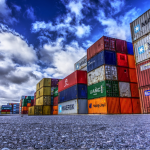Shipping Digitization: Challenge or Opportunity for Shippers’ Freight Forwarders?
This is a guest post by David Fan.
1. Background

News 1:
Demand for shipping consumer goods, manufacturing parts, and other staples of global trade are waning this year amid a slowing global economy and continuing tensions between the U.S. and China. Maritime data provider Alphaliner in late May cut its container volume growth estimate for this year to 2.5% from 3.6%.
News 2:
On June 24th, Twill appeared at the 16th China International SME Expo in Guangzhou, China. As an international logistics platform for small and medium-sized business customers, Twill participated in the China Expo for the first time, aiming to present a reliable, simple, visual, and intelligent one-stop online logistics management platform for small and medium-sized enterprise customers, facilitating international trade and expansion.
Twill is a digital logistics platform of Maersk Group that simplifies the customer’s shipping process. The platform was officially launched in April 2017 and became a Maersk brand in September 2018. From getting quotes, managing documents from shipping to warehouses, booking, management, and shipping monitoring can be done at the touch of a button — simple and convenient. Customers can easily complete their bookings through the Twill website and track their shipments in real time for details. In addition, all documents are stored centrally for easy access. The Twill team also provides customers with 24/7 professional services.
News 3:
The year of 2018, in the eyes of many shipping people, was a year of good harvest. Represented by the North American line, it seems that the high position and the freight rate remained high throughout the year. But the facts are very shocking. Shipping lines saw profit decreases. Maersk, the giant of the shipping industry, even had its net profit decline by 38.2% in 2018 compared to 2017. Compared with the bleakness of shipping companies, international logistics giants had experienced another scene. Not to mention Kuehne+Nagel International AG that had an annual profit of nearly US $10 billion, Kerry Logistics alone had a profit of nearly HK $2.4 billion in 2018, exceeding the profit of any shipping company including Maersk.

Judging from the above news, the international container liner transportation faces unprecedented difficulties: the global weak economy, the continuing Sino-US trade war, and the IMO2020 requirement of shipping companies to control pollution and implement low-sulfur navigation. How can the shipping company break the ice?
The profitability of the shipping company, like any other company, is determined by income and cost. The international shipping industry is a typical cyclical industry: in the boom cycle, the profitability of shipping companies will continue to grow, while once the global economy enters a recession, the hardships of shipping companies begin. Therefore, a considerable part of the shipping company’s performance is based on the macro economic environment. In the case of economic sluggishness, there are only a handful of shipping companies that can adjust properly to the changing situation and still keep the rise. From the perspective of income, in a bad economy, shipping companies have to pay more attention to the improvement of gross profit margin.
How to improve gross profit margin? With the traditional methods still applied, digitization has become a potential tool for the new era. Before talking about how digitalization can increase gross margin, we will review the traditional sales model of shipping companies in light of the Chinese market.
2. Analysis of the traditional operation mode of shipping companies in the Chinese market
As one of the world’s largest import and export trade countries, China has always been a battleground for many shipping competitors because of its huge container traffic. Shipping companies have invested a tremendous amount of money and manpower to explore the Chinese market. Since the international container shipping business involves many units, it is necessary to integrate the data flow, cargo flow, information flow, and other factors of the relevant companies in order to transport smoothly. For example, to export a container of children’s toy cars from the port of Shanghai to the port of VALENCIA in Spain. This seemingly simple transportation business requires at least the following processes:
1) To submit information to the carrier for booking
2) To receive confirmation through the booking company from the shipping company regarding the specific shipping time according to the booking information and the conditions of their containers
3) To arrange the truck to pick up the container at the door point and transport to the port according to the booking confirmation
4) To arrange export declaration
5) To check and issue transport documents
In the traditional mode, limited by the capability of data collecting and processing and the cost constraint, the shipping company as a carrier may only be able to participate in part of the work of Steps 1, 2, and 5. Therefore, between the shipping company and shipper or consignee, there must be one or more agents to process the data and integrate the requirements to help the shipping company complete the transfer of cargo flow, information flow, and capital flow. Otherwise, the shipping company cannot work smoothly.
The purpose of the shipping company’s agency designation is to develop and expand the business, allowing more end customers to use its services. The agent plays a role as defined on Wikipedia: A freight forwarder, forwarder, or forwarding agent, also known as a non-vessel operating common carrier (NVOCC), is a person or company that organizes shipments for individuals or corporations to get goods from the manufacturer or producer to a market, customer, or final point of distribution. Forwarders contract with a carrier or often multiple carriers to move the goods. A forwarder does not move the goods…
These intermediate jobs are the core work of the agent and the source of profit for the agent. In order to expand the business, the shipping company needs to give the agent some preferential conditions, that is, to transfer some benefits to the agent. In this way, the agent can obtain a certain volume of goods in the market, and provide the shipping company with the source of profits, i.e. container transportation business. In general, the shipping company will give qualified agents the following work and support:
1) Booking by the agent to the shipping company
2) Shipping price given by the shipping company to the agent
3) Exchanging data between the agent and the shipping company, confirming the documents, and issuing the bill of lading
Once the agent has these resources, it will have the profit margins to develop their subordinate agent or directly look for the shipper or consignee.
The shipping company works through several authorized core agents, and the core agents develop their own agents to bring the goods on the market into the logistics network through layers of agency.
To sum up, the relationship between the shipping company and the agent is both compromise and struggle. Compromise means that goals of both parties are relatively uniform, i.e. to increase profits and market share. The struggle means that there are many shipping companies and agents in the market, and the degree of homogenous competition is quite fierce. On the same route, there are often several shipping companies with different strengths, and competition is inevitable.
Therefore, the agents of various shipping companies are also fiercely competing on the same routes, and the price becomes a key part. Agents want to get better costs from the shipping company, but the shipping company also dynamically balances the price given to the agent based on the assessment results. For example, the agent will be given a certain volume target, only upon the accomplishment can the agent enjoy a preferential price matching with the volume. And this is another aspect of the struggle.
3. The shortcomings of the traditional model
The traditional model has been increasingly affected in recent years, and shipping companies are increasingly recognizing its shortcomings.
a) Shipping companies operating with heavy assets, and agency company light assets. In the case of excess shipping capacity, the shipping company will suffer.
Shipping companies often have to expand at the peak of the economy. New ship construction expenditures require a large amount of transportation business to cover. However, the construction period usually lasts for several years. When the new ship is launched, the economy may have passed the boom period and turned down. The ensuing global trade will also shrink, which will result in excess capacity. Excess capacity will force shipping companies to face fierce price competition.
For example, in the off-season a few years ago, the shipping price from the Chinese port to the South American East route actually fell to about 100 US dollars per 20GP container. The shipping company’s heart is bleeding, but in order to maintain the facilities that have already been launched, and the supporting terminals, they can only operate at a loss. For freight forwarders, there is no such pressure. They only need to guarantee that they will sell on the basis of the shipping company’s quotation, and there will be no big losses.
Returning to the above example, if the transportation cost is 300 USD, the shipping company will lose 200 USD when transporting a container. Moreover, the shipping company still has to transport, otherwise it will lose more. The freight forwarder will lose up to 100 USD, which is in the case of free transportation to the destination port.
Gradually, the shipping company would find out that agent may only share the prosperity but not the hardship. What’s more, agents may make the shipping company suffer more by pressuring for lower price. If the request is not satisfied, agents may change to another shipping company.
b) Freight forwarders control a large amount of primary sources of goods.
Although freight forwarders’ businesses are based on the transportation operation of the shipping company, many of the services in the shipping process are directly handled by freight forwarders.
Consequently, end customers have greater reliance and greater brand loyalty to agents. After accumulating certain customer resources, the agent may replace the cooperative shipping company for the pursuit of maximum profit. The result is that agents will have better profit margins and profitability, while shipping companies are relatively passive, and often confronted with unstable profit as the economic cycle changes. The high asset-liability ratio will make the shipping company more passive during the economic winter. The bankruptcy of Hanjin in 2016 is a typical case.
4. How digitalization solves the problems of the traditional model
The fatal shortcomings of the traditional model are changing with the fierce market competition and technological progress in recent years, and the existing relationship between agents and shipping companies is no longer unbreakable.
When the agent controls the cargo volume, it has obvious advantages in negotiating with the shipping company’s freight rate, and often forces the shipping company to give a very low price. And the price sold to end customers in the market is relatively high. That is to say, most of the profits are collected by the agent and not shared with the shipping company.
The shipping company found that if sold directly to a small freight forwarding company or even an end customer, there will often be more profit margins. In the past, limited by manpower, financial resources, and technology, shipping companies were unable to provide services directly to customers around the agency. However, the development of today’s technology enables shipping companies to directly serve customers through a more operational platform.
For example, Maersk has launched the Spot booking service for small and medium-sized agencies based on its own business requirements. As long as the registration on the Maersk platform is successful, small and medium-sized agencies can use this SPOT service for booking and shipping. The price is Maersk’s first-hand price, without any intermediate price difference. The end customer can get rid of the fare increase of the intermediate agent with just some supporting services (such as trailers, customs clearance). With the pioneering demonstration of Maersk, more and more shipowners are expected to follow. This will break the original pricing mechanism and bring new vitality and even revolution to this traditional market.
From the current trend and the status quo, it can be seen that the new model of the digital driving of the shipping company is still in its infancy. However, we believe that the digitalization of shipping is an inevitable trend in the future. The digitalization of shipping companies has been innovated in at least the following areas:
a) Direct quotes bypassing the middleman
In the digital mode, the customer gets the price from the shipping company on the platform, not through the agent. To achieve this, it is technically very simple. As long as the shipping company balances the price relationship between the agent and the platform, it will not affect the overall interests of the shipping company. This will leave the profit margin to the shipping company itself.
b) Simplify operations
By establishing a direct platform, the shipping company can make container shipping declarations, signing, and other processes more smooth than the traditional model. Customers can operate relatively simple tasks, rather than having to complete all the processes through a traditional agent. In this case, the customer only needs to deal with the single window of the shipping company, without the need for agents to participate in payment, document transmission, issuance, and so on.
c) Adjust route price through business data feedback
On routes that require promotion, the shipping company will release the preferential price. On certain routes with strong cargo volume, the shipping company can reduce supply through price and availability control on the digital platform to maximize the benefits, while at the same time balancing the demands between agents and end customers.
d) Gradually expand the service content
More and more shipping companies have carried out multi-modal transport routes. In the FCL transport business, they no longer focus on the single transport mode of port to port, but provide the relevant services through mergers or acquisitions or establishment of their own truck companies, customs clearance companies, and even document processing companies. These services were generally provided by international freight forwarding companies. From the previous mode of port to port to the present mode of end-to-end, the freight forwarding service penetration of the shipping company is believed to greatly increase its profitability and customer adhesion.
5. The key to the success of shipping digitalization
a) Robust and advanced inclusive platform
To sell and operate digitally, the shipping company needs a basic ecological environment, i.e. the platform. How to build a good platform is a top priority. Stability is reflected in security and confidentiality. It hasn’t been long since Maersk’s infection by the ransomware virus. If this kind of thing appears on the digital platform, the consequences are unimaginable.
The platform must take into account the entry of the shipping company, and more inclusive, forward-looking ideas to build access to the shipping company’s major suppliers, such as the truck company and the customs declaration company, without which no successful shipping can be expected. If the platform can give these companies the opportunity to participate or the access mechanism, it will greatly enhance the cohesiveness of the shipping company’s digital services.
b) Improved real-time digital services
To achieve a digital shipping ecosystem, customer service levels must be improved. Future digital shipping platforms may not require direct sales, but they cannot be disconnected from real-time online help. How to improve the real-time online help responsiveness and improve the efficiency of problem solving are all issues that must be considered in a successful digital platform.
c) Go deep into the market and consider the needs of the majority of end customers
The customer’s needs are the real needs. The problem that the digital platform has to solve must be the problem that the customer actually encounters, rather than the problem that comes up in the office and out of thin air. Everything must come from practice and eventually be applied pragmatically. If self-centered (shipping company focused), this digital platform will inevitably be abandoned by customers.
6. What should the traditional freight forwarder do in the digital age of shipping?
Now MAERSK has taken the lead in digitizing, and COSCO also has an e-commerce platform. We estimate that the digital sales of other shipping companies will also follow. As a traditional freight forwarder, we don’t have a second way to go. We can only embrace change, study hard, research the law, and find our right position. The following aspects are worth deepening:
a) Work hard and be familiar with the digital platform.
Smart freight forwarders will understand the ship company’s intentions on one hand and practice the digital model on the other. Such an agent will do a lot. Because we are in this industry, we have to know more about how to operate on the platform than direct customers. Only in this way can we let our customers continue to use our services.
b) Form a benign docking cooperation with the platform.
The digitization of shipping companies requires the integration of various international logistics participants. Although the shipping company may acquire a number of different units to participate in the supporting truck transportation, customs clearance, and other aspects of shipping, more experienced international freight forwarding companies should be more more adept than the shipping company at these jobs. We can integrate our services to better match the digital system platform of the shipping company, and thus participate more deeply in the digitization process of the shipping company.
c) Change the profit model and concept.
It is important to recognize that the core profit model of freight forwarders in the future is not the difference in freight rates but the increase in service value. Only by improving the service can we be invincible.
d) Make good use of the financial functions of the shipping digital platform.
Utilizing digital platforms for optimal results will be important.
For example, the price of a digital platform can be locked at the time of booking. If we are in an upward trend, we can lock in the price early and avoid rising costs due to rising market prices. On the contrary, in the off-season, we can wait for the price to fall, and then reserve the space before packing. In this way, profitability can be achieved.
7. Conclusion
The digitalization of the shipping company will undoubtedly revolutionize the sales and operating models of the current container shipping market. The fundamental purpose of the shipping company is to use technical means to expand the control and adhesion to the end customers to a certain extent and within a certain range, so as to improve their profitability and reduce the profit pressure during the economic downturn.
This trend is actually a very good benefit for our small and medium international freight forwarding companies. The digitization process of the shipping company has changed our price channel, which gives us the opportunity to reduce our reliance on the first-level agent, and to some extent to narrow the cost gap with the first-level agent. This allows us to focus more on serving our customers.
The digital development of shipping companies will have many variables in the future. The only constant is that we must always maintain a positive learning posture to adapt to a variety of changes. If there is a pool of stagnant water, we cannot see hope. From this perspective, shipping digitization is at the right time for us.
This was a guest post by David Fan.
Author Bio
David Fan, Co-founder of Zhejiang Twingsupply Chain Co., ltd.
In the freight forwarder industry since 2001, he has rich experience in container shipments from China to worldwide.
His company’s website: https://www.twingsupply.com
His company’s blog: https://www.twingsupply.com/blog/





Your blog is very informative. Here you talk about the Shipping Digitization: Challenge or Opportunity for Shippers’ Freight Forwarders. Thanks for sharing this information.